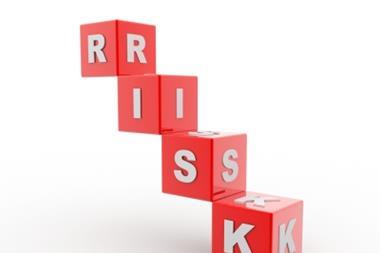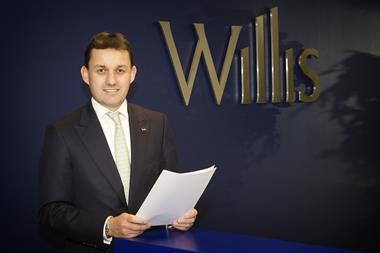ACE European president Andrew Kendrick urged insurers to become more service focused in a Q&A with StrategicRISK after the launch of ACE’s Emerging Risks Barometer 2013
Insurers must adopt a more consultative approach and become service oriented to keep up with client expectations, says ACE Group European president Andrew Kendrick.
Kendrick believes the key risks facing businesses require alternative tactics to the traditional approach of product supply, which insurers have harboured up to the present day.
Kendrick was responding to the results from ACE’s Emerging Risk Barometer 2013, which surveyed leaders in 650 companies in Europe, the Middle East and Africa (EMEA).
The results revealed a ‘big four’ that EMEA bosses believe are most likely to significantly financially damage their businesses over the next two years being: infrastructure and supply chain (45%), environmental risk (42%), cyber risk (40%) and directors’ and officers’ (D&O) liability (40%).
In a Q&A with StrategicRISK, Kendrick picks out ‘lack of management focus’ (57%) being the most significant barrier to effective risks management as his most surprising statistic and talks in detail about the survey results.
Which result from the study surprised you the most?
We were most surprised that the biggest barrier to the effective management of emerging risks was lack of management focus. As 57% of respondents across Europe, rising to 68% in the UK, cited lack of management attention as the biggest barrier to managing emerging risks. In our view, this suggests that emerging risks are not yet embedded as part of board-level discussion on wider risk management issues. This in turn leads onto the second and third challenges – lack of human resources and lack of risk management tools and processes.
Of course, how we identify and monitor emerging risks is far from straightforward. It requires non-traditional approaches and being open to dissenting voices that challenge received wisdom.
However, the dynamic nature of today’s risk environment means that it should be a growing priority for companies with the right capabilities and processes to monitor their emerging risks, as part of a broader enterprise-wide approach to risk management. Chief risk officers clearly have an important role to play in this – leading the corporate response to these challenges, monitoring new threats and pinpointing the right issues for management’s attention.
What does the survey tell us about the current fears facing most senior executives?
Some risks, such as cyber risk, are relatively new. Others like environmental and D&O risks, have been around for a long time, but have taken on a new dimension due to social, economic and regulatory change. Indeed, the impact of increased regulation is a theme which crops up repeatedly in our research. So too does the impact of increasing globalisation, which is creating new exposures, as companies expand abroad via more complex, extended supply chains.
While high tech supply chains are now the backbone of many businesses, they are increasingly vulnerable – particularly as companies continue to try and drive down costs. Failing to strike the right balance between a lean supply chain and a resilient one can lead to crippling losses, as evidenced post the 2011 tsunami in Japan and the more recent horse meat scandal in Europe last year.
Compounding this complexity for risk managers is the fact that risks are often interconnected. Real world events do not respect neat categories. An environmental incident affecting an important supplier in Thailand can quickly become a supply chain risk with a severe financial impact for a company on the other side of the world. Understanding the interdependencies between different processes, operations and players in the global supply chain is one of the most critical tasks an organisation can undertake, and one of the most challenging.
Why do you think infrastructure and environmental risks are placed so high? – What has changed over the last few years to make them the top two emerging risks?
Supply chain and infrastructure risk ranked number one with 45% of businesses and environmental risk second with 42% of respondents categorising them as the emerging risks most likely to have a negative financial impact on their business. The infrastructure risk is linked to the reliance on creaking civil infrastructure in many established and emerging economies. In addition, there is the security of international energy and power supplies, and a potentially small group of specialist or emerging market suppliers able to meet their growing demands.
Regulation also plays an important role, particularly for environmental risk. There are currently more than 17,000 separate environmental regulations that address air, water, land and soil contamination around the world. In addition, three-quarters of the companies surveyed say their shareholders are taking environmental risk more seriously and are more vocal about this issue. This increased pressure from both regulators and stakeholders to protect the environment has made environmental liability risk climb inexorably up the corporate agenda, and the potential financial impact of both supply chain and environmental risks are now grabbing the attention of c-suite executives.
How has the insurance market responded to these emerging risks? – What kind of innovation are you seeing in reaction from the insurance sector?
There are a number of specific insurance products on the market designed to address a range of emerging risks, and, interestingly, a lack of insurance options ranked the lowest in the list of barriers to the management of emerging risks.
But what is clear from the research results is that the insurance industry as a whole – including underwriters, brokers, claims managers and loss adjusters – needs to communicate more effectively with the risk managers we serve.
The big four risks that top our risk barometer (infrastructure and supply chain 45%, environmental risk 42%, cyber risk and D&O risk 40%) clearly require a more consultative approach. If the insurance industry is to meet client expectations it needs to shift from a ‘product’ to a ‘service’ mentality and clients need to shift from a transactional to a strategic approach to their insurance partnerships. This way, insurers can partner better with companies on their risk management and risk transfer strategies, and it will require insurers, brokers and clients to share more and better quality information.




















No comments yet